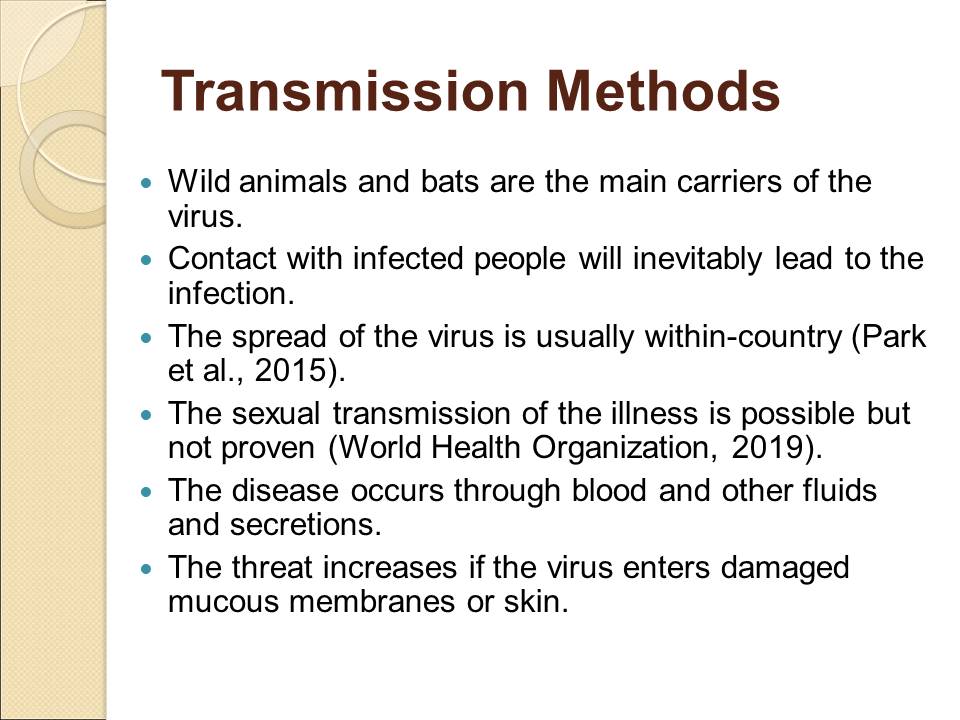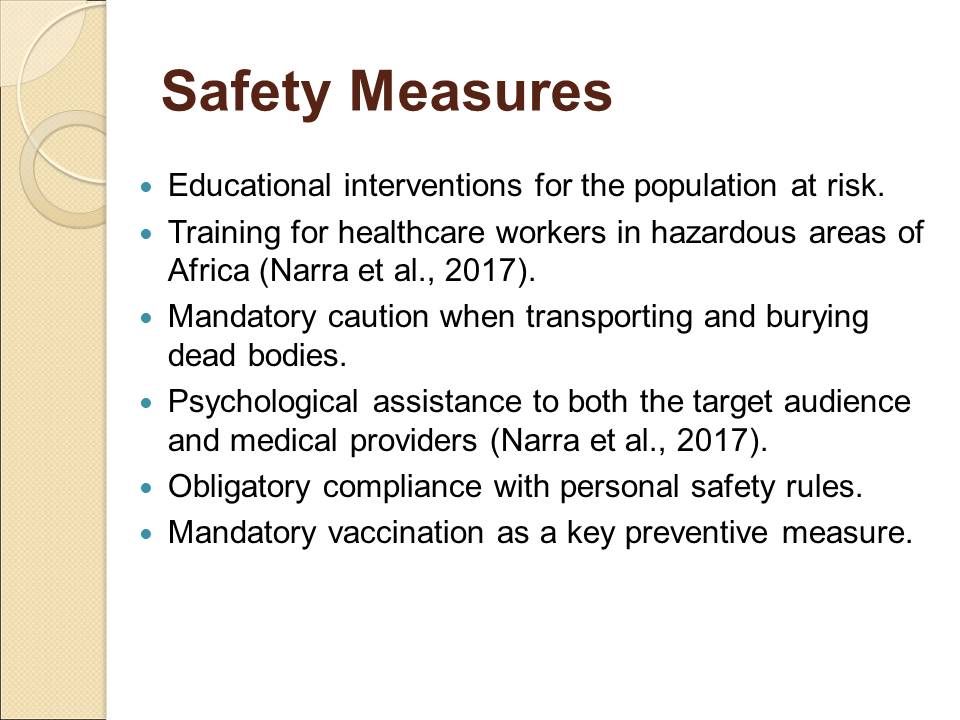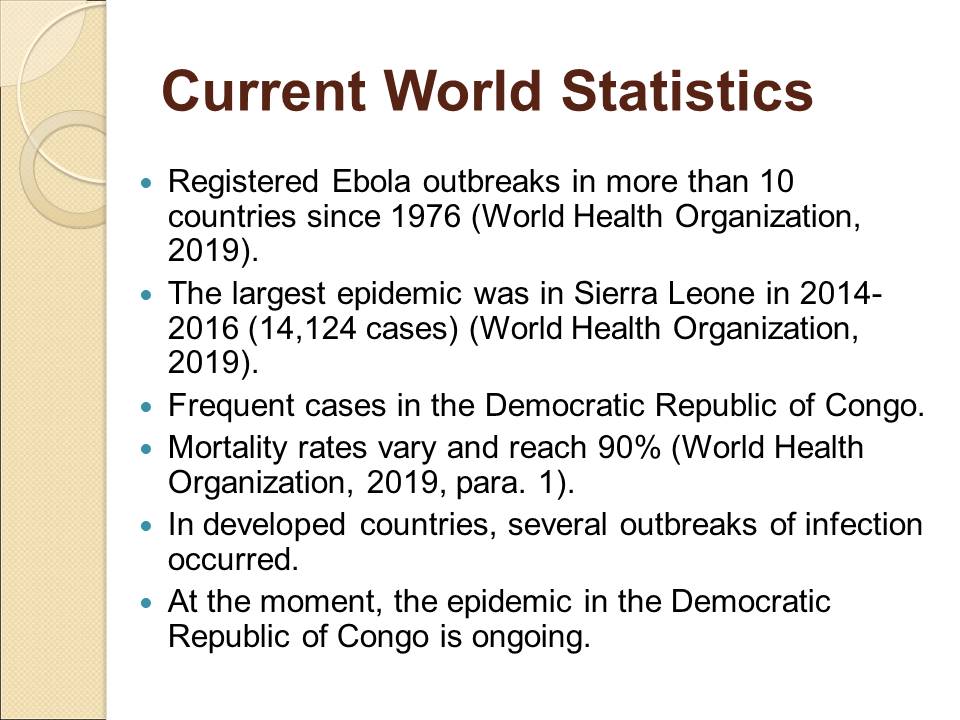Introduction
- A dangerous and deadly Ebola virus poses a significant threat.
- The spread of the disease may be rapid.
- Mass epidemics prove the danger and need for prevention.
- Healthcare and state interventions are mandatory.
- Prevention is more important than treatment due to significant mortality statistics.
- Future safety measures include vaccination and special control at transport hubs.
Ebola virus is an extremely dangerous viral infection with a high risk of mortality. Due to the danger of rapid spread, timely preventive interventions are needed in vulnerable areas. Some massive epidemics in African regions have proven the threat of the illness and the importance of timely protection. The treatment of the disease is almost ineffective; therefore, healthcare and government interventions are mandatory. Enhanced monitoring at transport hubs and ongoing medical examinations are the essential aspects of preventive activities.

Disease Discovery
- First registered in 1976 in the Democratic Republic of the Congo (Park et al., 2015).
- Outbreaks in the northern regions of the continent were reported (Park et al., 2015).
- Later, in different parts of Africa, Ebola manifested itself.
- The origin of the virus remains unknown until now.
- Wild animals and bats are considered carriers of infection.
- In poor areas, contact with wild animals is inevitable.
The first cases of Ebola were reported in 1976 in the central region of Africa, but later, the outbreaks of the infection were identified in other areas. Researchers cannot determine the exact nature of the virus and do not have reliable data on who are the carriers of the disease. Wild animals and bats are thought to be hosts for the infection. In the areas under consideration, where the standard of living of the population is not high, contacts with fauna may be fraught with contamination.

Problem Description
- The rapid spread of the infection in case of an epidemic.
- The likelihood of stable transmission from person to person is extremely high (Park et al., 2015).
- The danger of epidemics in low-health areas.
- Both patients and healthcare providers are at risk.
- Ebola mortality rates can reach 90% (World Health Organization, 2019, para. 1).
- Infected bodies are dangerous even after death.
The Ebola threat is significant due to a number of factors, in particular, the high risk of transmission from person to person and extremely high mortality rates. Different stakeholders are at risk of infection, which creates additional challenges. Special burial principles should be applied since infected bodies pose a threat even after death due to the persistence of the virus. Poor healthcare status in some regions areas is an additional problem.

Epidemiology of the Disease
- 33 outbreaks of the disease have been reported (Martínez, Salim, Hurtado, & Kilgore, 2015).
- The virus belongs to the family of filoviruses (Martínez et al., 2015).
- The disease is rare and often fatal.
- The virus is transmitted from animals and spreads among people.
- Early supportive care promotes recovery and survival.
- Vaccination is the only possible preventative treatment.
Since the discovery of Ebola, 33 outbreaks have been reported, and they all occurred in Africa. The virus belongs to the family of filoviruses, and its strains may vary. The disease is extremely dangerous and often fatal, although recently, the vaccine against the virus has been invented to resist the threat. Early supportive care may help recover and avoid inevitable death. As one of the few treatment options, vaccination is an effective protective measure.

Transmission Methods
- Wild animals and bats are the main carriers of the virus.
- Contact with infected people will inevitably lead to the infection.
- The spread of the virus is usually within-country (Park et al., 2015).
- The sexual transmission of the illness is possible but not proven (World Health Organization, 2019).
- The disease occurs through blood and other fluids and secretions.
- The threat increases if the virus enters damaged mucous membranes or skin.
The rapid transmission of Ebola virus from person to person is one of the main threats. Also, the danger comes from infected fluids that can enter the body of a healthy person through mucous membranes and damaged skin. Sexually transmitted infection is considered one of the likely routes of Ebola transmission, but today, there is no conclusive evidence of this theory, which explains the need for further research.

Safety Measures
- Educational interventions for the population at risk.
- Training for healthcare workers in hazardous areas of Africa (Narra et al., 2017).
- Mandatory caution when transporting and burying dead bodies.
- Psychological assistance to both the target audience and medical providers (Narra et al., 2017).
- Obligatory compliance with personal safety rules.
- Mandatory vaccination as a key preventive measure.
Although Ebola is an extremely dangerous and almost incurable virus in case of progression of the disease, some safety measures may help protect both the population and medical staff, who are also at risk. Vaccination should be promoted as a mandatory procedure, and compliance with personal safety measures through special protective equipment is necessary. Also, the transportation and burial of dead bodies deserve particular attention due to the danger of the virus in corpses. All medical staff should receive special training, and interaction with psychologists is an important practice.

Disease Symptoms
- Dehydration caused by prolonged and excuriating vomiting (Narra et al., 2017).
- Diarrhea that may be accompanied by bleeding (Narra et al., 2017).
- External and internal hemorrhages requiring resuscitation (Narra et al., 2017).
- Severe fever not reduced by conventional antipyretic drugs.
- Impaired functioning of kidneys and liver.
- Frequent headache and regular sore throat.
Some Ebola symptoms are similar to fever, but in addition to high temperature, additional problems arise – regular vomiting, headaches, sore throat, bleeding, and even kidney and liver failure. Traditional medicines may be ineffective, and potent medicines are to be used to relieve symptoms. Since no interventions are effective at the late stage of the disease, if any signs of the infection are detected, immediate consultation with medical specialists is mandatory to prevent an epidemic and stop the virus from spreading.

Historic Treatment Specifics
- Historically, epidemics have occurred within one country (Martínez et al., 2015).
- The forces of domestic healthcare systems have constantly been involved.
- Isolation has been a basic principle of public protection (Martínez et al., 2015).
- Blood transfusion was used earlier to cleanse the body (Martínez et al., 2015).
- No Ebola vaccination was carried out until 2015 (Martínez et al., 2015).
- Patients received standard care based on symptoms.
Since Ebola has been known as a disease for over 40 years, certain care principles have been developed. However, some historical aspects of treatment are still promoted as basic interventions. In particular, isolating patients has always been a natural measure, and blood transfusions have been used. As a rule, an epidemic has arisen within one state, and local health authorities were involved in addressing the problem. Vaccination was not carried out, which affected high mortality rates.

Contemporary Treatment Principles
- Introducing anti-GP antibodies of monoclonal nature (Martínez et al., 2015).
- Small and interfering RNAs, or siRNAs (Martínez et al., 2015).
- “Favipirarvir is a nucleotide analog and viral RNA polymerase inhibitor” (Martínez et al., 2015, p. 374).
- Plasma administration during the recovery phase.
- Using interferons to treat the infection (Martínez et al., 2015).
- Supportive care treatment implying constant patient monitoring.
Modern methods of Ebola treatment involve using highly effective antibodies of monoclonal nature, which act on the virus and destroy it. Also, RNA-based microbodies are utilized to inhibit the development of the disease. At the stage of remission, plasma is introduced into the blood of patients to maintain their normal health, and constant monitoring is conducted. As traditional drugs, interferons are used to minimize the symptoms of the illness and relieve fever.

Prevention Techniques
- Establishing a regime of careful interaction with wild animals.
- Minimizing the risk of contracting the disease through sexual contacts.
- Constant adherence to sanitation and hygiene.
- Using sterile medical instruments and gloves.
- Food is to be cooked thoroughly (World Health Organization, 2019).
- Excluding contacts of potential Ebola patients with other people.
In order to protect oneself and one’s loved ones from Ebola infection, it is crucial to adhere to simple safety principles. When interacting with wild animals, special protection measures should be taken to exclude damage to the skin. Hygiene principles are to be respected, and any medical devices should be handled through sterile procedures. Any food made from animal protein is to be cooked thoroughly to prevent infection from entering the body. If the illness is suspected, the patient must be isolated from others.

Volunteer Help
- Engaging international volunteers is relevant and encouraged (Narra et al., 2017).
- Qualified employees prepare to work in hazardous conditions.
- Special courses are organized for volunteer program participants (Martínez et al., 2015).
- Work in both clinical and social fields is conducted.
- Volunteers involved help the medical staff and gain valuable skills.
- Healthcare authorities recruit local residents regularly.
Volunteers are often recruited to help healthcare providers conduct operations in the risky environment of the epidemic. International organizations encourage this activity and urge all concerned people to help. Special training programs are designed to help people adapt to difficult working conditions. Volunteers participate both in clinical work and in the social sector, interacting with patients and their families and providing psychological support to those affected by the illness. Assistance from local healthcare authorities is also mandatory and essential.

Healthcare Regulations
- Collaboration among healthcare organizations to provide care (Glynn & Boland, 2016).
- Joint trials to develop effective drugs.
- Creating a special unified preventive strategy.
- Appeals for blood donation and assistance to the population of the affected regions.
- Obligations imposed on local healthcare authorities.
- Sanitary and epidemiological control in different places (Glynn & Boland, 2016).
International healthcare organizations work in a single vector to create a reliable system of prevention against Ebola. Special regulations are also promoted, which contain the rules and working duties of medical specialists and volunteers in the conditions of infectious epidemics. Specific principles of sanitary-epidemiological control are developed to prevent the spread of the infection and minimize the risks of contamination. The collaboration of local medical providers with world organizations helps to constantly replenish available resources for interventions.

Current World Statistics
- Registered Ebola outbreaks in more than 10 countries since 1976 (World Health Organization, 2019).
- The largest epidemic was in Sierra Leone in 2014-2016 (14,124 cases) (World Health Organization, 2019).
- Frequent cases in the Democratic Republic of Congo.
- Mortality rates vary and reach 90% (World Health Organization, 2019, para. 1).
- In developed countries, several outbreaks of infection occurred.
- At the moment, the epidemic in the Democratic Republic of Congo is ongoing.
Since the discovery of the disease in question in 1976, numerous epidemics have occurred, and most of them took place in African countries – the Democratic Republic of Congo, Sudan, Gabon, Uganda, Sierra Leone, and others. At the same time, a few cases of the Ebola outbreak have also been reported in the USA, the UK, Italy, and Spain, which indicates the threat of the spread of the illness outside countries. The largest epidemic occurred in Sierra Leone in 2014-2016, but since then, several new outbreaks have been reported, and today, the disease is rampant in the Democratic Republic of Congo.

Current US Statistics
- Four reported cases in 2014 (World Health Organization, 2019).
- One death, which is 25% of all the infected (World Health Organization, 2019).
- More than five hundred trained employees to work in Africa in 2015 (Narra et al., 2017).
- Preventive measures are taken in many healthcare facilities.
- The monitoring of the public medical indicators.
- Most of the allocated funds are spent on personal protective equipment (Narra et al., 2017).
Despite the advanced US healthcare system, four cases of Ebola were reported in the country in 2014, and one case was fatal. Since then, no data have been received on new patients with such a diagnosis, which indicates the sufficient safety of the population and an effective preventive strategy. Assistance programs for affected countries develop intervention and humanitarian assistance strategies. Personal protective equipment allocated to the members of volunteer teams requires the highest costs of all the expenses.

Governmental Interventions
- Strengthening border control to prevent the virus entry (Glynn & Boland, 2016).
- Compulsory blood tests upon arrival from countries at risk (Glynn & Boland, 2016).
- The increased monitoring of large transport hubs.
- Allocating funds for healthcare organizations.
- Guidelines for checking products coming from potentially hazardous areas.
- National emergency programs are designed to respond quickly.
Based on the danger that the virus can carry, governments of different countries, including the United States, take measures to prevent this outcome. Border controls are tightened, and all passengers arriving from areas of high risk are to take a blood test immediately upon arrival. Also, national protection programs are designed to respond to any outbreak timely and to be prepared to deal with the threat of the epidemic. In addition, food products undergo mandatory certification to ensure there is no contamination.

Future of Treatment
- Experimental therapies with the development of innovative vaccines (Bishop, 2015).
- Predicting an outbreak before an epidemic spreads.
- Engaging various stakeholders, including private pharmacological companies (Bishop, 2015).
- The treatment of complicating infections to prevent the development of Ebola (Bishop, 2015).
- Complexes of drugs that perform therapeutic and supporting functions.
- Identifying the virus based on environmental assessment.
Plans for addressing Ebola and treating this infection are based on the use of highly effective drugs that block the spread of the disease. Also, the interaction of official agencies with private companies is seen as a potentially beneficial cooperation. Environmental analysis may help identify the threat of an epidemic. As medications, both blockers and supportive drugs will be offered to reduce Ebola mortality. This measure will also give an opportunity to minimize the harmful effects of the virus on a human body.

Basic Control Measures
- Full public awareness of the dangers and methods of infection.
- Avoiding contacts with body fluids of other people.
- Control over the compulsory vaccination of the population (Bishop, 2015).
- Tracking any cases of Ebola-like illnesses.
- Thoughtful logistics to ensure the safety of transport (Narra et al., 2017).
- Improved hospital transmissions to ensure patient safety (Park et al., 2015).
In order to prevent the outbreak of the Ebola epidemic and protect vulnerable populations, it is essential to provide a set of measures aimed at minimizing threats. The control over compulsory vaccination should be mandatory, and educational interventions should be part of a protective program. To prevent the transmission of the disease, all transport routes should be thought out carefully. In addition, the hospital transmission of patients with suspected Ebola should be as safe and isolated as possible.

Conclusion
- The dangerous Ebola virus requires a number of preventive principles.
- A high threat of epidemics, based on current statistics.
- Not a sufficiently clear transmission mechanism.
- Symptoms and consequences of the disease require compulsory vaccination.
- Involving various resources to prevent the virus is encouraged.
- Developing the new methods of prevention and treatment is crucial.
Ebola virus is extremely dangerous, which numerous epidemics and high mortality prove. Based on available statistics, African countries are most at risk, but several reported cases in other states explain the importance of the necessary preventive work. Today, vaccination is one of the potentially effective protective mechanisms, but personal safety measures are no less crucial. A large number of stakeholders, including volunteers and official healthcare organizations, are involved in the work to eliminate the consequences of epidemics and prevent them. Highly effective drugs are developed regularly, and future Ebola treatment may be less stressful.

References
Bishop, B. M. (2015). Potential and emerging treatment options for Ebola virus disease. Annals of Pharmacotherapy, 49(2), 196-206. doi:10.1177/1060028014561227
Glynn, R. W., & Boland, M. (2016). Ebola, Zika and the International Health Regulations – Implications for port health preparedness. Globalization and Health, 12(1), 74. doi:10.1186/s12992-016-0173-9
Martínez, M. J., Salim, A. M., Hurtado, J. C., & Kilgore, P. E. (2015). Ebola virus infection: Overview and update on prevention and treatment. Infectious Diseases and Therapy, 4(4), 365-390. doi:10.1007/s40121-015-0079-5
Narra, R., Sobel, J., Piper, C., Gould, D., Bhadelia, N., Dott, M., … Fischer, W. A. (2017). CDC safety training course for Ebola virus disease healthcare workers. Emerging Infectious Diseases, 23(Suppl 1), S217. doi:10.3201/eid2313.170549
Park, D. J., Dudas, G., Wohl, S., Goba, A., Whitmer, S. L., Andersen, K. G., … Winnicki, S. M. (2015). Ebola virus epidemiology, transmission, and evolution during seven months in Sierra Leone. Cell, 161(7), 1516-1526. doi:10.1016/j.cell.2015.06.007
World Health Organization. (2019). Ebola virus disease.